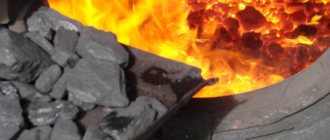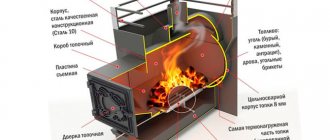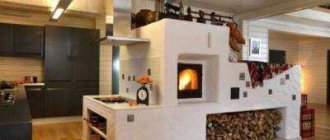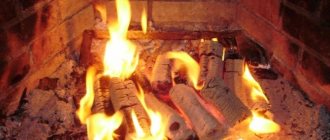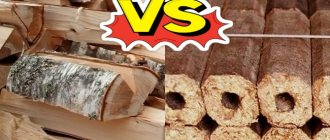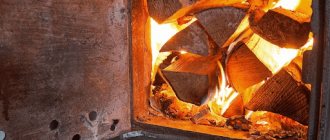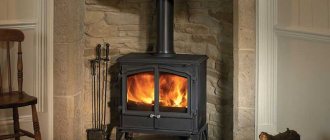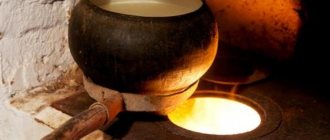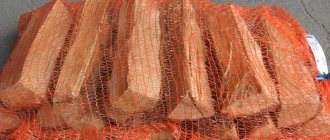Gas and electric furnaces are no match for a wood-burning or fireplace. The point here is not even the quality of heating or the cheapness of raw materials, but the special microclimate, the natural woody aroma that reigns in a room with a wood-burning stove. Many people enjoy the process itself, the sound of crackling firewood. But you need to know how to heat a stove with wood. The temperature of the resulting heat, the uninterrupted operation and safety of the entire procedure depend on the quality of the firewood, the ability to heat it correctly and quickly, and add it on time.
Preparing the stove for kindling depending on its condition
And only a brick oven that is lined, which is constantly used, and one that has been idle for a long time, have their own characteristics when starting up. Let's learn how to properly light a Russian stove yourself, depending on its condition.
Wet oven
Melting only a brick-lined stove should take into account the following nuances:
- The first fire is made with small wood and lasts no more than one hour.
- After this, the oven is allowed to rest for 3-4 hours. You should close the firebox door and the damper on the chimney pipe. The resulting heat from burning wood will be evenly distributed throughout the entire structure.
- Once the unit has completely cooled down, you need to heat it again for one hour. In this case, it is better that the firebox door is closed all this time and no firewood is added. This way, warm air will remain and be held inside the oven, preventing it from cooling.
- The stove is allowed to rest and cool again by closing the firebox door and the damper on the chimney.
A fresh stove needs to be heated in this way several times until condensation stops forming on the fresh masonry and the walls of the chimney pipe and the structure finally gains strength.
After a long period of inactivity
Photo: stacking firewood in the firebox
You need to be especially careful when lighting a wood-burning stove that has not been used for a long time. When igniting, black smoke may emit. To reduce the amount of smoke, it is better to first light a small fire of small wood chips so that the chimney warms up and reaches operating temperature. As soon as the smoke emitted becomes less and it becomes lighter, you can safely put in larger logs and heat them according to the accepted standard safety rules.
In working mode
Before the stove starts heating, you need to thoroughly clean the firebox and grates from burning and soot, clean the chimney if necessary, and seal all cracks in the brickwork with clay (this does not apply to metal stoves).
An important point is to check the quality of the raw materials for the firebox. It should be dry. This applies to both firewood and coal. Wet, damp firewood leaves condensation on the walls when burning, and the chimney becomes more quickly contaminated with smoke. A water plug may form inside the pipe, causing the draft to become worse.
The quality of the draft can be checked by inserting a burning match or piece of paper inside the firebox.
Having completed the preparation, you can start heating the stove as usual. You need to lay small chips and paper at the bottom, thicker logs on top and ignite. You can control the combustion process using the firebox doors, damper damper, ash pan, by adjusting the closing and opening.
Thematic material:
- How to plaster a brick stove
- How to install a chimney
Preparatory work before lighting the stove
If the stove is new, the first test fire should be carried out only after the solution has completely dried. It is done to check the quality of the masonry and identify shortcomings. The first stage is an external inspection, while paying attention to:
- seam thickness;
- correct ligation of bricks;
- verticality of corners;
- precision fitting of tiles.
Unevenness of the masonry is allowed within 5 mm for stoves without cladding, and no more than 2 mm for tiled structures. Vertical deviation - no more than 2 mm per 1 m height.
An oven with a hob performs several functions at once
After an external inspection, it is necessary to check the density of the masonry. This is best done using a material that emits a large amount of smoke when burned. Rags soaked in diesel fuel or waste will do. Burn them in the channel with the valve closed, making sure that no smoke escapes anywhere. If it does appear, then these places need to be sealed and rubbed.
Checking the chimney draft with a candle is one of the easiest ways
The test fire should be carried out for 2–3 days in a row with a normal amount of fuel. The degree and uniformity of heating is determined by touching different places on the masonry surface. The oven should not only heat up equally everywhere, but also cool down. It is important to check the surface for cracks on the arch of the firebox, in the places where the doors are fastened, and eliminate them in a timely manner.
If it so happens that the stove has not been used for a long time, then before the first fire you should check the condition of the chimney and draft. To do this, light the paper or match and insert it into the oven through the viewer door. If there is draft, the flame will tend towards the chimney. If it is insufficient, the chimneys must be cleaned of soot. It is recommended to carry out this procedure 1-2 times a season. This will reduce fuel consumption and reduce combustion time.
Features of stacking firewood in the firebox
Correctly heating a Russian stove with wood means being able to correctly place it in the firebox.
It is important to note here that:
- It is advisable to place the logs in the center of the firebox or a little closer to the door.
- Firewood should be placed in rows or in a cage. In both cases, the wood will burn out to the end, releasing maximum heat. It is important to leave a distance between logs of 8 to 10 mm. Small gaps ensure good air exchange and high-quality combustion process.
- The height of the firewood stack should be at least 20 cm less than the height of the ceiling of the combustion chamber. With a larger stack, the fire will enter the chimney and will not linger in the firebox.
It is important that the wood is burned in the firebox, ensuring its uniform heating and maximum heat transfer.
Choosing firewood for the stove
Depending on the type of firewood, different amounts of heat are released inside the stove, and the time and quality of combustion differ. Let’s take a closer look at which firewood is worth paying attention to and which ones are better to avoid.
Aspen
You can get a well-heated rustic stove if you use aspen wood. Their properties are similar to alder, which will be discussed below.
The main advantage of aspen firewood is that it produces almost no smoke during combustion and helps clean the chimney of soot.
Black soot and soot accumulated on the walls of the chimney, under conditions of intense combustion, will begin to crumble inside the stove, thereby improving the release of gases and draft. But heating a stove with an aspen in a residential building or in a country house in winter is unprofitable due to the low heat transfer. It is used to heat baths and saunas. The aroma of firewood has a pleasant aroma and healing properties. An excellent option is to clean the chimney channels after burning with pine wood.
Willow, poplar
It will not be possible to heat a house with such logs in winter. Poplar and willow have low heat transfer, and dry firewood burns out quickly. Their only advantage is their low price. It is acceptable to use it in the fall and spring to warm up the garage and utility rooms, when it is not possible to order high-grade wood such as oak or maple firewood.
Apple tree
Apple and pear logs are an excellent option for barbecue, smoking meat and fish at home. Suitable for heating living spaces. Their heat output is high. When the fire is kept on for a long time, the room will be hot and a pleasant fruity aroma will appear. It can be used as the main solid fuel, or in combination with harder wood species (ash, oak, maple).
Oak
The best option for solid wood fuel. It has a hard, dense structure. It has maximum heat transfer, allowing you to retain heat in the room for a long time. Oak wood is easy to light a fire with. The heater will quickly gain temperature. In terms of heat transfer, oak is second only to ash. The consumption of wood for heating even large rooms is small. This is an indispensable type of firewood for cold winters.
Suitable for various types of furnace equipment with both open and closed fireboxes. When burned, oak releases a pleasant aroma. Among many wood species, it is the most valued and therefore expensive.
Birch
Birch firewood is a special type of wood. Most often used to flood a bathhouse. They give off wonderful heat. The aroma released during combustion is considered healing and beneficial for the respiratory system, strengthens the immune system.
It is important to take into account that birch firewood is suitable for burning in the first year; then it quickly becomes rotten and loses its properties.
Birch, its bark (birch bark) burns even when wet, so it is convenient to melt with it. The reason for this is the presence of tar in wood. The logs burn almost completely, leaving little ash.
Alder
Photo: aspen firewood
In nature, there are up to 25 species of alder, and all of them are excellent for heating houses and baths at any time of the year. The use of this firewood was in demand even in tsarist times; it was alder logs that were used to heat the stoves in the houses of various nobles. Even damp firewood dries naturally if left in a ventilated, dry place.
An important advantage of alder is that it will not smoke when burned. Alder emits vapors that cause soot to lag behind the walls of the chimney, thereby cleaning the passage.
Alder is actively used to fire stoves and potbelly stoves in bathhouses, as it emits a healthy and pleasant aroma. gives good heat. Even after 2-3 years of storage, firewood does not lose its properties. Alder sawdust is an excellent raw material for smoking fish and meat.
Ash
In terms of heat transfer, it can only be compared with oak, having an indicator even higher. Rarely available for free sale, expensive. This is a tree with a very strong and dense structure. When harvesting firewood, you have to cut it into pieces several times.
Ash, like birch, is convenient for lighting a stove. Logs burn in the firebox even when damp, do not spark and do not emit a lot of smoke.
Ash wood is indispensable for heating a residential building or bathhouse. They will allow the room to heat up quickly and retain heat for a long time.
Linden
Linden wood burns quickly and produces a lot of heat. Linden is most often used for heating steam rooms and dressing rooms. The logs emit an excellent healing aroma, which helps strengthen the immune system after a cold and quickly cope with respiratory diseases. It is rarely found on sale in large quantities, therefore it is almost never used as the main fuel for residential buildings.
We recommend that you read the article: “Do-it-yourself firewood splitter.”
Stages and process of wood burning
Being able to quickly and competently light a stove is half the battle; it is equally important to know how to properly regulate the draft and ensure constant, even burning of wood.
The following help to monitor and make adjustments to the process:
- firebox door;
- ash door;
- gate;
- chimney damper.
Blower doors and fireboxes allow you to control air exchange, making it more or less. Using a valve and gate, you can control the draft inside the firebox.
First you need to open the firebox door and close the blower door, other valves must also be open.
Once the fire is well lit, the procedure is performed step by step in reverse order. The blower door opens and the furnace door closes.
You can easily tell whether wood is burning correctly by the color of the flame:
- White. There is a strong draft inside the firebox. It is better to close the blower door.
- Red with black smoke. You should hurry up and open the vent. The thrust is too low.
- Yellow or almost transparent. Optimal color of fire. The wood burns evenly. There is normal draft inside the oven.
The cause of red or white smoke from the chimney may be clogged ducts or a clogged chimney. An effective way is to let the oven reach a temperature of 90 degrees. Under the influence of heat, all accumulated debris inside the pipe will simply evaporate.
Nuances of ignition
Our ancestors also advised that anything that burns can ignite a heating unit. Take the materials that you have available: hay, straw, old newspapers and magazines, birch bark from sawn dies, plastic dishes, plastic bottles, sawdust and shavings.
By the cold season, you should carefully check the condition of your stove, clean the chimney of last year's soot, remove ash and old coals from the furnace, check the serviceability of the grate, and check the draft with lit paper. Make sure your latches and lids open and close smoothly, so there are no unnecessary gaps. Only after all the manipulations can you begin the heating process.
Lighting a heater or stove does not require fuss or acceleration. Be patient, otherwise you will not only have to sit near the unit for a long time, but also ventilate the entire room from carbon monoxide. If you lit a “hut” of wood chips and started to smoke, do not panic. Open the ash pit, close the firebox and wait until the accumulated smoke stops the fire and leaves through the hole, simultaneously warming up all the pipes. After a few minutes, try again, just add more dry material. Alder or aspen are best suited for cleaning a chimney, as they will help burn off last year's resinous deposits. When the combustion has stabilized and draft has appeared, you can start laying wet firewood. Just watch the intensity of the fire so that the water does not extinguish it.
You must remember that the filling of the firebox at the initial stage does not exceed 30 percent of the volume of the chamber itself. After the temperature of the brick becomes optimal, that is, the heater is warm at hand, you can add wet logs every 2 hours. In this case, it is strictly forbidden to close the damper and vent completely. They should be slightly open to increase the heating time.
When is it necessary to add firewood to a stove firebox?
To determine when it's time to add more firewood, it's important to consider the following:
- A new pile of firewood should be done when good smoldering coals remain from the previous one. If you do this earlier, it is simply an uneconomical use of fuel.
- The logs need to be laid across the grate, slightly away from the furnace door (combustion chamber). After adding firewood, the firebox doors must be closed immediately so as not to disturb the normal air exchange in the stove.
- It is important to check and periodically clean the ash pit from accumulated ash. Excessive amounts of it can interfere with normal traction.
It is important to clean the surface of the furnace equipment from dust at least occasionally. After all, when heated to a high temperature, the dust on the surface will begin to burn and emit an unpleasant aroma.
What other materials can be used to fire the stove?
As an alternative to wood, the stove can be heated with other raw materials. Suitable for the firebox:
- Briquettes, pellets from peat, sawdust, sunflower seed waste. The raw materials are thoroughly dried, mixed with a viscous mixture, poured into molds, pressed and exposed to high temperature. Such briquettes do not burn, but smolder, so they can be placed in the oven overnight, and in the morning there will still be coals left. It is inexpensive, and the ash will also serve as a good fertilizer.
- Gorbyl. This is waste from processed logs, tree trunks, most often pine trees. A croaker's car doesn't cost much. But the disadvantage of such fuel is that it burns out quickly, releasing a lot of tar, and smokes. The chimney will have to be cleaned more often. The heat from it is several times less than from firewood or briquettes.
- Processing of machine oil. Used for quick lighting of the stove. If you pour oil on even damp wood, it will start to burn. The downside is an unpleasant pungent smell. This is an auxiliary fuel, not a primary one.
- Coal. Suitable for heating stoves. They can be used to heat all day or night. In warm weather, you can take breaks. The stove will continue to give off heat from the coals for a long time, but coal costs even more than wood.
- Boards, sawdust and other waste from the woodworking industry. Suitable for heating a room. They are not suitable for heating in winter - they burn out quickly.
- Dry mullein, dung. Lights up easily and produces a lot of heat. This fuel option is found in villages where there is a lot of free land and the owners keep large and small livestock. Combine with firewood to reduce wood consumption and provide better heat.
Paper, hay, straw, and branches of dry trees are used for kindling.
About kindling
So, the firewood has dried, you can start lighting the stove. First you need to make sure that the firebox and ash pit or ash box are cleared of ash and unburnt coals. The room must be ventilated to increase its oxygen content and equalize the pressure inside and outside the room. Before lighting, the ash pan should be closed and the damper on the chimney should be opened completely and not closed the entire time the stove is firing. Place paper on the grate, logs on top of it, and set the paper on fire. While it is burning, a temperature is created in the stove that is sufficient for the cast iron or fireclay lining of the stove to warm up smoothly and the logs to ignite. It is not recommended to use wood chips to heat the stove - they produce a lot of heat, and a sudden temperature change can cause cracking of the cast iron. If the stove is smoking, you need to check whether the damper is open and wait for the chimney to warm up before loading it full of firewood. Sometimes, to warm up the chimney, they use burning paper or a torch over a deflector (chimney tooth) and only then proceed to ignition in the firebox. No flammable liquids, including those sold in hardware stores for lighting barbecues, should be used to light the stove - this could result in a fire or damage to the internal lining of the stove. After igniting the kindling, you need to open the ash pan slightly, but do not immediately close the firebox door tightly, since soot will immediately settle on its cold surface. This is especially important for ovens with vitroceramic glass doors. Cast iron fireplace stoves or metal potbelly stoves, equipped with an air intake system from the street or from the basement, do not have an ash, so combustion in them is controlled using air supply regulators.
When the kindling has flared up, you can lay down the logs. Methods for placing logs in a firebox are an important part of knowledge about how to properly fire a stove. You can arrange the firewood in horizontal rows, making sure that the stacking is not too dense, but also without large gaps between the logs. Another way is to lay the first log diagonally on the grate, and all subsequent logs on top at an angle to the first. The third - laying firewood in a cone or “hut” - is possible in large fireboxes using short logs. These methods ensure uniform air access to each log. The volume of filling required by the furnace firebox is recommended by the manufacturer, taking into account the fact that 1/5 of the combustion space should remain free. Firewood is loaded into the firebox of kitchen stoves in several reduced stacks.
Furnace firing depending on the time of year
Taking into account the temperature outside and the weather outside the window, the stove is heated differently.
In summer
In summer, a wood-burning stove is used for cooking, heating water, preserving and performing bath procedures, so there are no strong restrictions on the amount of firewood. Even breeds with low heat transfer are suitable. This practice is a rare occurrence, but it still occurs among grandmothers in villages.
in autumn
With the onset of cold weather, it is already necessary to heat the room. In the fall, one or two stacks of firewood are enough to heat up the house and stay warm until the morning. The main thing is to follow safety precautions, otherwise you may get burned.
in winter
In severe frosts, you need to take only hard wood (maple, oak, ash), lay logs in a timely manner, and observe the loading interval depending on the volume of the firebox. Before winter, you should thoroughly clean the chimney of soot and do not forget to periodically clean the soot from the vent.
in spring
In spring, as in autumn, it is enough to heat the building once a day. You need to load the firebox well and let the wood burn slowly.
A brick oven will give off heat for at least 12 hours, even when the logs burn out.
This is enough to maintain a comfortable temperature in the house during the spring season.
We start with competent laying of firewood
It is necessary to carefully prepare the stove mechanism for the heating procedure.
In standard industrial furnace models, you need to work using three main components - a combustion chamber, a specialized smoke and burning system, equipped with a blower and a device for storing ash from firewood - an ash pan. It must be thoroughly cleaned of any remaining ash remaining from the time of the previous kindling - an excessive amount of this substance will interfere with the access of air to the stove. This will significantly slow down the ignition process. In most stoves, the ash pan is a small compartment, so cleaning it will not take much time and effort from the stove maker. After completing the preparation, you can proceed to the next stage - laying firewood.
When it comes to how to properly fire a wood-burning stove, working with the chimney and blower systems plays an important role.
- Before starting work, open both channels to fill the combustion chamber with oxygen.
- While interacting with the smoke exhaust duct, open the shaft damper leading from the combustion chamber to the roof outlet.
- Prepare the required amount of fuel to start work, as well as to complete the entire heating process.
- The initial mass of firewood for kindling should be at least one third of the total volume of the stove chamber.
- Only good quality firewood must be used.
Examples of loading firewood:
Example 1
Example 2
Example 3
The first ignition is a responsible event. You should not try to light a stove with raw wood - all material for heating the stove must be easily and quickly flammable. Otherwise, there is a risk of wasting a huge amount of it, but not achieving the desired goal - to light the stove so that it is warm.
It is necessary to ensure that the base of the combustion material is well dried. At first, it is good to lay thinner wood logs first. It is possible to use various auxiliary means - dry paper from old books or newspapers, well-dried tree bark before starting work.
Features of the combustion chamber of stoves made of different materials
The material of the furnace equipment determines the characteristics of the unit and whether combustion will take place in it correctly.
Brick
A classic version of the Russian stove. With skillful installation it will last 100 years or more. Brick retains heat for a long time and gives off heat. There is no risk of getting burned on the walls of the equipment. It has large dimensions, so the consumption of firewood is quite high. It is installed both in bathhouses and residential buildings of different sizes.
In order for a cooled brick oven to heat up and begin to give off heat, it will take up to 3-4 hours of intensive heating. Then you can load the firewood and leave it to smolder just to maintain the desired temperature level. An oven with a stove is convenient to use for cooking and heating water.
Metal
In recent years, a metal stove has become a worthy alternative to a brick stove. It is placed in country cottages, small houses, baths. It is compact, heats up quickly and begins to give off heat immediately. It is important not to overheat a metal structure, otherwise this will significantly shorten the service life of the metal and can lead to a fire. For kindling, it is better not to use flammable mixtures that are sold in stores, especially if the stove is installed in the middle of the house. Some of the toxic odor will still remain in the room and residents will have to breathe it in, so it’s better to take paper and matches.
The walls of such a stove heat up to a high temperature, so children need to limit access to it so that they do not get burned.
Along with rapid heating, the oven also cools quickly. You need to ensure that firewood is loaded into the firebox in a timely manner.
To keep the room warm longer, you can build a brick screen around the stove.
There are many types of stoves available for sale with varying power and combustion volume. To start using it successfully, you need to buy it and install it correctly.
Cast iron
A more reliable alternative to a metal stove. Capable of serving for decades. Heavy. The metal will not burn or rust. Cast iron retains heat well and gives off heat for a long time. It is important to simply close the ash door and always keep the fire door closed.
When laying firewood, it is important to open the damper and close the ash pan, otherwise smoke will begin to pour out of the stove into the room.
Cast iron stoves are often equipped with a stove top for one or two burners. This is convenient because you can cook food without wasting gas or electricity.
How to properly heat a sauna stove
The main rule for lighting a sauna stove is to ensure that there is no carbon monoxide or smoke in the room.
To do this, you need to adjust the opening/closing of the dampers. There must be good air exchange.
It is better to extinguish the coals remaining in the firebox in a container with water. You should not use coniferous wood for the firebox, as they emit resin. It is better to give preference to deciduous species - oak, ash, linden, alder.
It is important to comply with safety requirements, especially for wooden baths. The floor around the stove for 1.5 m should be covered with a sheet of metal to avoid fire. The same applies to the section of the ceiling around the chimney.
Additional material: “Choosing stones for a sauna stove.”
What type of wood is best for firewood?
Different types of wood differ from each other in their calorific value and combustion characteristics. In this regard, when choosing fuel, you need to understand the performance characteristics of firewood.
- Pine has a high combustion temperature. The reason for this is the high resin content. This rock suggests many voids where tar deposits are present. When burning, they produce micro-explosions, sparks and ignited pieces of wood fly away.
- Spruce is less efficient in a firebox than pine. It contains less resins. Splitting wood is easy, but when burning the tree smolders and smokes. These conifers can be used for heating only in extreme cases.
- Alder. The main feature is the ability to burn without forming soot. At the same time, during combustion, deposits in the chimney will also be burned out. Such characteristics are unique to aspen.
- Poplar. It burns out quickly without providing enough heat. It should not be used to heat a bathhouse, but it is quite suitable for a home.
- Birch. Burns hotter than beech with acacia and oak. But there is also a drawback, and a significant one. It is necessary that there is sufficient air flow into the combustion chamber. Otherwise, there will be no heat, but only tar and smoke on the walls of the chimney.
- Oak. It is distinguished by its high density and ability to release heat. Its characteristics are similar to ash and also resemble beech. Oak wood is quite heavy when splitting.
- Maple. Its wood burns quickly without forming coals, as a result, there is a need to constantly add fuel. It's like burning linden wood.
- Apple trees. Like other fruit species, it pricks well and produces enough heat when burning. Apple firewood is also preferred because of the pleasant smell in the room.
Here's what else the stove maker said.
Current issue: is it worth opening a business with automatic devices for charging gadgets?
Read at three in the morning and more: unique habits of the most successful people
The price of secondary housing in Sevastopol has reached 150 thousand rubles per square
Step-by-step instructions on how to quickly light the stove
Kindling is done like this:
- Pieces of crumpled paper are placed in the firebox, with chips of logs, dry tree branches, and birch bark on top. After that, several large logs are placed - the firebox should be only a third full - and set on fire. The damper damper and the blower door must be completely open. The firebox door closes.
- As soon as the fire is well lit, you can load the firewood by laying it in a cage pattern across the grates. There should be at least 10 cm left to the top. The blower door, the gate is closed a little.
- The combustion process must be controlled and regulated by furnace valves. The fire in the stove should be yellow.
- It is better to use logs of the same size for the main stash. There will be no risk that the fire will go out, and the wood will burn evenly.
- To complete the fire, the coals are pulled to the center, wait until they burn out completely, and close all the dampers.
When closed, the oven will retain and release heat for several more hours.
If you have glass smoking near the stove door...
In any oven there are times when glass smokes. This often happens during kindling, when the stove is still cold or the air lock has not been “broken.” The combustion temperature is not yet high, and there is a lot, a lot of unburnt gases, smoke, which does not have time to escape and can swirl around the glass of the door.
Glass blowing measures do not always help, although we try to make fireboxes with glass ventilation. It may be trivial to have damp firewood (among other things).
What to do in such a situation?
Just try for the first 15-30 minutes of the fire, while the wood is burning, open the fire door 0.5-1 centimeter, this is enough to cut off the smoke from the glass. This will also provide additional oxygen for lighting the stove. With this calculation, you can open the blower a little less.
Furnace Maintenance
To make the stove last longer, you need to follow several recommendations:
- Before the start of the heating season, seal cracks and gaps on the brick surface.
- Before and after winter, thoroughly clean the chimney. If the pipe becomes clogged more often, then do this as necessary.
- Do not forget to clean the grate and remove ash from the chamber before lighting.
- Do not use old things, bags, or plastic containers for the fire, which stick to the grates and emit acrid smoke.
- Clean chimney ducts from soot in a timely manner.
Keeping the stove clean allows the combustion process to occur as efficiently as possible.
Chimney cleaning before the start of the heating season by specialists
The chimney cleaning service is available in: heating industry specialists will carry out a full range of measures for servicing the chimney:
- Inspect the internal contour of the chimney for the presence/absence of dirt, debris, soot build-up and condensation. Cleaning the internal circuit from any detected contaminants using special devices.
- Inspection of the external contour of the chimney for the presence/absence of damage, cracks, depressurization, inspection of the condition of joints and fastenings, insulation. Eliminate any detected defects and damage promptly.
- Lighting up the heating device, checking the draft level, the quality of the flue gas output, comprehensive testing of the performance and safety of heating and smoke exhaust equipment.
- Drawing up a certificate of work performed and providing warranty obligations.
Attention! If you clean the smoke duct yourself, it is recommended to follow fire and technical safety measures, as well as use specialized devices - a brush, a cable with a load, and others.
How to keep your home warm longer with less wood consumption
You can achieve economical consumption of firewood and heat in your home if you do not open the vent too often.
Having added a new portion of firewood, when combustion is stable, you need to cover the ash pit and keep it in this position until a new addition. The temperature will be kept at the desired level and the wood will burn slowly and evenly.
Safety precautions: how not to get burned by the stove
The main dangers of stove heating are toxic carbon monoxide, the risk of fire and burns. To avoid this, it is important to follow a few tips:
- Check the condition of the stove and chimney ducts before starting the fire.
- Do not use gasoline or other flammable mixtures for kindling.
- Try to always finish heating a few hours before bedtime.
- Do not accelerate the oven above the permissible temperature.
- When installing the stove, adhere to fire safety.
- Keep children away from the stove equipment. Do not leave them alone with a hot oven.
- Do not place furniture or interior items near the stove that can quickly catch fire.
By adhering to basic safety rules when operating the stove, you can avoid irreversible consequences and not put the health of loved ones at risk.
General information
The designs of most types of furnaces have a centuries-old history; they are created in such a way that minor mistakes of inexperienced stokers cannot cause significant harm. The main threats remain:
- excessive fuel consumption and financial losses;
- danger of carbon monoxide poisoning.
The energy efficiency and safety of liquid and gaseous fuel stoves are directly determined by the design features of the models and do not depend on the skill of the owner.
The design of gas-fired furnaces does not allow increasing their efficiency by adjusting the stroke Source bestpechi.ru
The combustion process of solid fuel proceeds differently, so a competent firebox can significantly reduce the cost of heating rooms (up to 40%). It consists of several phases:
- at the first stage, thermal decomposition of organic matter occurs with the release of flammable gases;
- pyrolysis gases ignite, releasing energy that heats the carbon base of the fuel;
- the carbon base heated to the ignition temperature produces the remainder of the total heat inherent in a particular type of fuel.
The correct course of the gasification process is most important for firewood, since the pyrolysis gases released during their combustion form a significant proportion of the heat given off by the material as a whole. They are able to easily activate its carbon base, but quickly burn out, and the stove does not have time to absorb all the energy produced by the fuel. As a result, heat evaporates into the pipe, and the structure is subjected to deformations, contributing to its premature wear.
A stove that could not withstand regular violation of operating rules and the destructive effects of time Source pyromasse.ca
